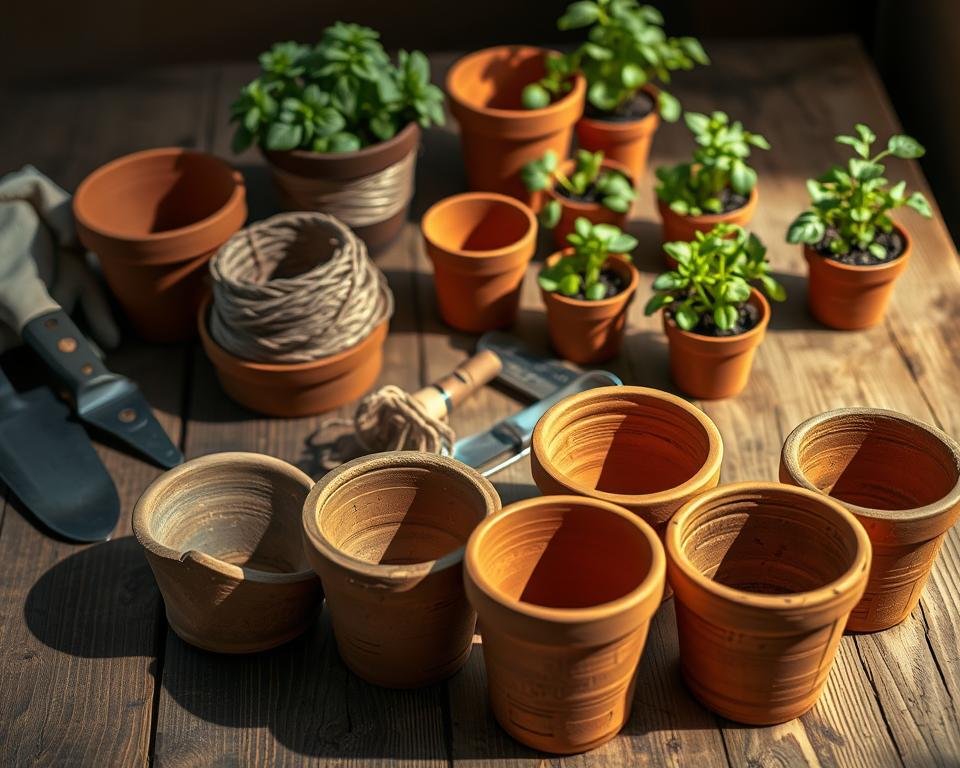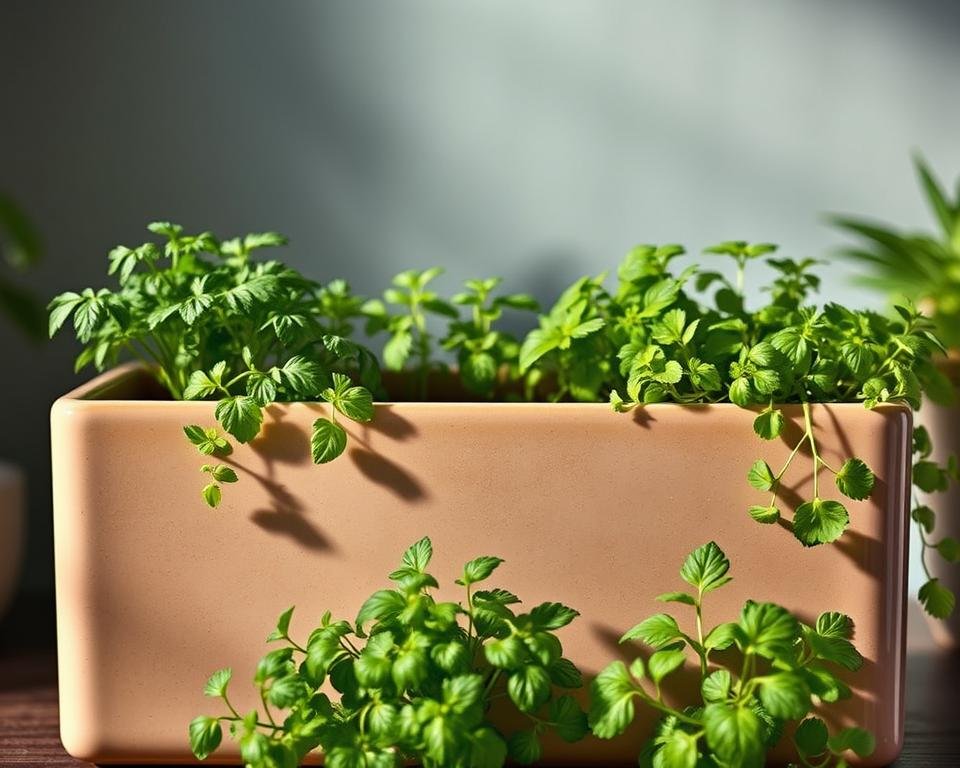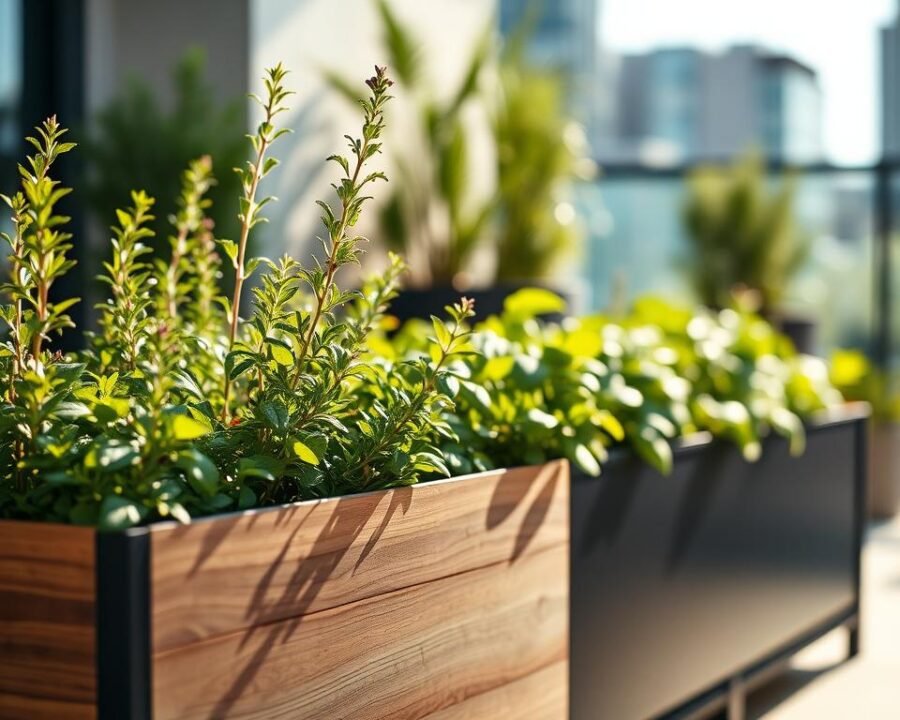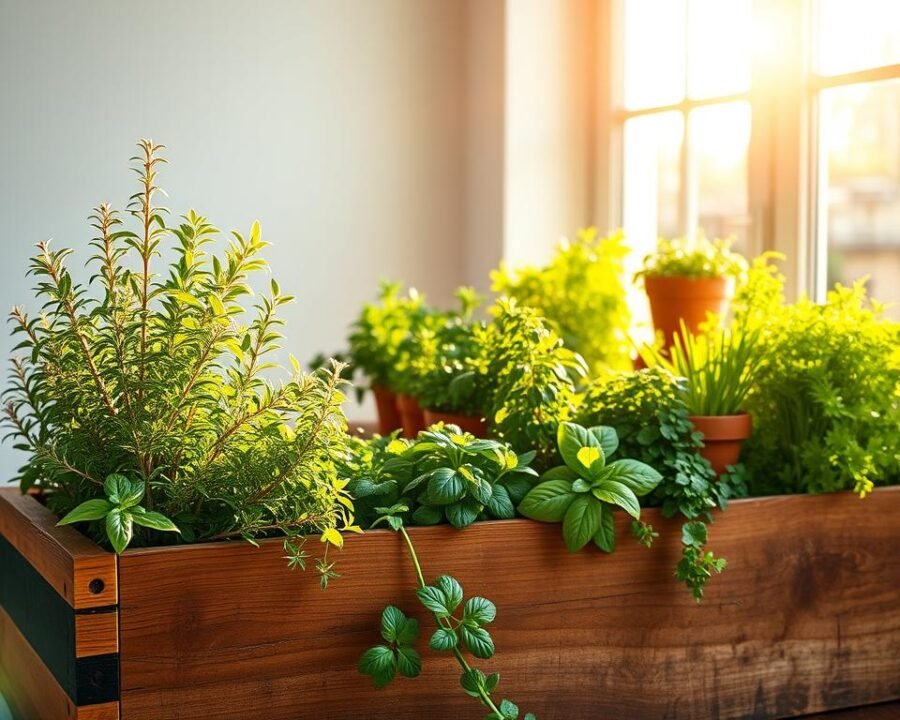There’s something magical about stepping outside and snipping fresh herbs for dinner. Whether you’re working with a tiny balcony or a sunny windowsill, growing your own herb garden brings flavor and life to everyday meals. We’ve tested countless setups and found that the right container makes all the difference.
Fresh herbs save money and elevate home cooking. No more wilted store-bought bundles—just vibrant, aromatic leaves ready to enhance your dishes. Even beginners can thrive with low-maintenance picks like chives or basil.
From compact EarthBox systems to stylish ceramic pots, we’ll guide you through top choices for every space. Let’s turn that corner of your garden (or kitchen) into a thriving, tasty oasis.
Key Takeaways
- Fresh herbs enhance meals and reduce grocery costs.
- Small spaces like balconies work well with the right container.
- Easy-to-grow options like chives are perfect for beginners.
- Versatile planters suit both novices and seasoned gardeners.
- EarthBox systems offer efficient, space-saving solutions.
Why Growing Herbs in Planters Is a Game-Changer
Imagine plucking basil for pasta without stepping outside—planter-grown herbs make it possible. These compact powerhouses transform small areas into productive green spaces. Whether you’re in a high-rise or a suburban home, containers adapt to your lifestyle.
Space-Saving Benefits for Urban Gardeners
City dwellers love herb planters for their efficiency. A 6-8″ pot fits snugly on fire escapes or windowsills. Traditional garden beds require 10x more space—a luxury many don’t have.
| Feature | Planter | Garden Bed |
|---|---|---|
| Space Needed | 1 sq ft | 10 sq ft |
| Mobility | Easy to move | Fixed location |
| Soil Control | Customizable | Limited |
Easy Access to Fresh Flavors Year-Round
80% of parsley growers keep plants near kitchens. No more last-minute store runs—just snip what you need. One reader froze pesto cubes from window-grown basil all winter.
Control Over Soil and Drainage
Mediterranean herbs like rosemary thrive in slightly alkaline soil, while mint prefers moisture. Planters let you tailor conditions. Proper drainage holes prevent root rot, a common issue in cramped pots.
- Self-watering systems cut maintenance by 40%.
- Rotate containers to chase sunlight.
How to Choose the Best Garden Planters for Herbs You Need to Try
Not all pots are created equal—some keep herbs happy, while others stunt growth. The right container balances materials, size, and drainage to match your plants’ needs. Let’s break down the essentials.

Material Matters: Terra Cotta, Wood, or Plastic?
Terra cotta breathes well, preventing soggy soil, but dries out fast. Plastic retains moisture, ideal for thirsty mint, while cedar wood resists rot outdoors. Pro tip: EarthBox Junior’s plastic design works wonders for compact thyme.
Size Guidelines for Small vs. Large Herbs
Chives flourish in 6–8″ pots, but rosemary demands 12″ depth. Oversized containers trap excess water, harming roots. For basil bushes, aim for 10–12″ diameters. Keep mint isolated—it’s a notorious spreader!
The Importance of Drainage Holes
Without drainage holes, roots drown. If your favorite pot lacks them, drill 1/4″ holes in the base. Pair with a saucer to protect surfaces.
“Healthy herbs start with dry feet—never let them sit in water.”
- Terra cotta: Best for drought-tolerant herbs like oregano.
- Plastic: Lightweight and budget-friendly for indoor setups.
- Wood: Stylish and durable for patios.
Essential Features of a Great Herb Planter
A great herb planter isn’t just about looks—it’s about durability, convenience, and adaptability. The right container ensures your herbs thrive with minimal fuss. Let’s explore the must-have features that make planters stand out.

Durability for Indoor and Outdoor Use
Materials matter. UV-resistant plastic withstands harsh sunlight, while cedar wood resists rot in humid climates. Terra cotta breathes well but may crack in freezing temps. For year-round use, opt for sturdy designs like EarthBox’s $34 kit with lime buffer for soil balance.
| Material | Best For | Lifespan |
|---|---|---|
| UV Plastic | Sunny patios | 5+ years |
| Cedar Wood | Humid climates | 3–4 years |
| Terra Cotta | Indoor/covered | 2–3 years |
Self-Watering Systems for Busy Gardeners
Wicking systems keep herbs hydrated for days—perfect for vacations. EarthBox’s reservoir design reduces water frequency by 40%. Pro tip: Pair with mulch covers to lock in moisture and deter pests (73% fewer issues vs. ground planting).
Mobility for Sunlight Optimization
Wheeled planters let you chase sunlight effortlessly. Rotate pots daily for even growth. In winter, move frost-sensitive plants indoors. Lightweight containers (under 10 lbs) simplify the process.
- Drainage holes prevent root rot—drill them if missing.
- Group herbs with similar water needs in one box.
Top Herbs to Grow in Your Planter
Fresh flavors start with the right herbs—let’s explore top picks for your planter. From sun-loving basil to drought-resistant rosemary, each brings unique perks and challenges. Here’s how to match them to your space and style.

Basil: The Sun-Loving Favorite
Basil thrives in 6+ hours of sunlight. Pinch stems regularly to boost yields by 30%. Greek basil works well in small pots—try shaping it into decorative topiaries.
Mint: Vigorous but Invasive
Chocolate mint tolerates partial shade, but its roots spread aggressively. Keep it solo to avoid overtaking neighbors like parsley. Harvest leaves often to control growth.
Rosemary and Thyme: Drought-Tolerant Picks
These Mediterranean herbs prefer dry soil. Use rosemary skewers for BBQ meats—a flavorful hack. Pair with thyme in sandy soil mixes for optimal drainage.
- Variegated sage adds visual interest with striped leaves.
- Freeze Hungarian parsley in ice cubes for winter use.
Where to Place Your Herb Planters for Maximum Growth
Location is everything when growing vibrant herbs—smart placement boosts flavor and yield. Whether you’re working with a sunny patio or a cozy windowsill, matching your container to the right spot ensures healthy plants. Let’s explore how to leverage light, space, and seasonal changes.
Sunlight Requirements for Different Herbs
Basil craves 6+ hours of sun daily, while mint tolerates shade. South-facing windows provide 85% of outdoor light—ideal for Mediterranean varieties like rosemary. Use a sun-tracking app to map exposure in your home.
- Full sun: Rosemary, thyme, oregano (6–8 hours).
- Partial shade: Parsley, chives, mint (3–4 hours).
Balcony, Patio, or Windowsill?
Concrete balconies absorb heat, creating microclimates—great for heat-loving herbs. Shaded patios suit moisture-sensitive varieties. Windowsills work year-round; just rotate pots weekly for even growth.
| Location | Best For | Tip |
|---|---|---|
| Balcony | Sun-lovers | Use wheeled stands to chase light. |
| Windowsill | Compact herbs | Add DIY grow lights in winter. |
Seasonal Adjustments for Winter Care
Chives survive -30°F, but tender herbs like basil need protection. Move containers indoors during frost warnings. Overwintering stats show 68% thyme survival in pots with mulch insulation.
“Rotate indoor herbs weekly—even growth prevents leggy stems.”
Caring for Your Herb Planter: Tips and Tricks
Keeping your herb planters thriving requires smart care—here’s how to master it. Whether you’re nurturing basil or rosemary, small adjustments to watering, pruning, and feeding make a big difference. Let’s dive into the essentials.
Watering Do’s and Don’ts
Overwatering drowns roots, while underwatering stresses plants. Use the finger test: insert a finger up to the second knuckle. If the soil feels dry, it’s time to water. Mediterranean herbs like oregano prefer drier conditions—wait until the top inch is parched.
Morning watering reduces evaporation. Avoid splashing leaves to prevent mold. Self-watering pots are a game-changer for busy growers.
Pruning and Harvesting for Continuous Growth
Regular snipping encourages bushier herbs. For parsley, use the “cut-and-come-again” method: trim outer stems first. Oregano’s flavor triples when dried—harvest before flowering for peak intensity.
Always use clean shears. Remove yellow leaves promptly to redirect energy to healthy growth.
Fertilizing Without Overdoing It
Monthly feeding boosts yields by 22%, but balance is key. Organic options like fish emulsion enrich soil slowly. Synthetic fertilizers work faster but risk salt buildup.
Skip nitrogen-heavy mixes for rosemary and thyme—they thrive in lean conditions. Pro tip: Sync fertilizing with lunar cycles (new moon boosts nutrient uptake).
- Group herbs with similar needs to simplify care.
- Rotate plants weekly for even sun exposure.
- Mulch retains moisture and deters weeds.
Companion Planting: Herbs That Thrive Together
Strategic pairings can transform your herb containers into thriving mini-ecosystems. Grouping compatible varieties boosts growth, deters pests, and maximizes flavor. We’ll explore ideal matches—and which plants to keep apart.
Best Pairings for Moisture-Loving Herbs
Basil and parsley are a dynamic duo. Studies show their combination increases pesto yields by 18%. Cilantro, chives, and parsley form another power trio—all thrive in evenly moist soil.
For themed containers, try an Italian mix: basil, oregano, and thyme. Their shared love for humidity makes care effortless. Just ensure proper drainage to prevent sogginess.
Drought-Tolerant Herb Combinations
Rosemary and sage are natural allies. Both prefer dry conditions and repel pests—rosemary wards off 89% of cabbage moths. Pair them with lavender for a fragrant, low-water garden corner.
| Group | Herbs | Perks |
|---|---|---|
| Mediterranean | Rosemary, thyme, oregano | Shared sun/water needs |
| Aromatic | Sage, lavender, marjoram | Pest-resistant |
Herbs to Keep Separate (Like Mint!)
Mint’s aggressive roots can overwhelm neighbors. Quarantine it in a submerged container—or solo pots. Avoid planting dill near carrots (they attract shared pests).
- Edible flowers like nasturtiums pair well with sage for color and flavor.
- Learn more about compatible herb groupings for your space.
Conclusion
Growing fresh herbs in containers brings flavor and joy to any home. Whether you choose an EarthBox for its efficiency or a ceramic pot for style, the right setup makes all the difference.
Share your progress with #HerbPlanterJourney—we’d love to see your thriving garden. Grab our free companion planting chart to pair flavors like a pro.
Ready for more? Explore our guides on freezing basil or building raised beds. Your kitchen deserves those vibrant, homegrown touches.
Your pesto awaits!
